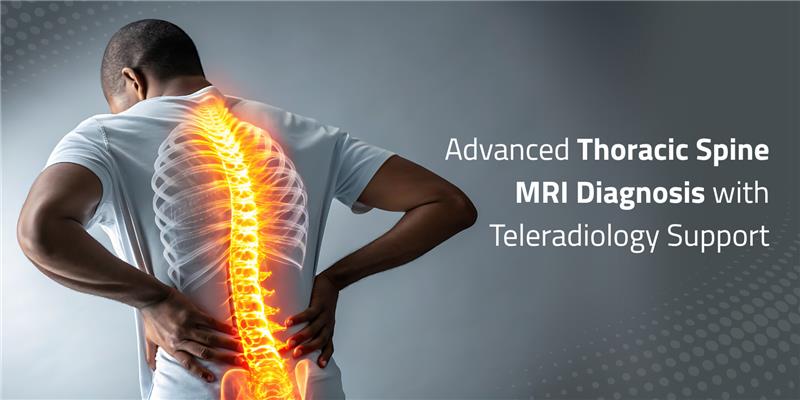

Teleradiology
MRI Spine Thoracic: How Teleradiology Enhances Faster, Accurate Diagnosis
Introduction
The thoracic spine plays an important role in stabilizing the upper body and protecting the spinal cord. When issues arise in this region, they can lead to pain, neurological symptoms, or functional limitations that affect daily life. One of the most effective imaging techniques to evaluate the thoracic spine xzis MRI Spine Thoracic.
Magnetic Resonance Imaging (MRI) offers detailed visualization of bones, discs, nerves, and soft tissues. However, accurate interpretation is crucial. That’s where teleradiology is transforming care—by ensuring faster, accurate, and accessible reporting no matter where the patient is located.
The Growing Need for Thoracic Spine MRI
Thoracic spine disorders are less common than lumbar or cervical problems but can be just as serious. Conditions like disc herniation, spinal stenosis, trauma, infections, and tumors often require MRI for precise evaluation.
With rising rates of back pain and sedentary lifestyles, thoracic imaging is increasingly requested. Hospitals and clinics are under pressure to deliver results quickly. Teleradiology bridges this gap, connecting scans with radiologists who can provide rapid interpretations. It also supports early detection, reducing the risk of long-term complications that can occur if conditions are left untreated.
What Does an MRI Spine Thoracic Show?
A thoracic spine MRI provides highly detailed images of:
- Vertebrae – Detects fractures, alignment issues, and degenerative changes.
- Intervertebral discs – Identifies bulges, herniations, and degeneration.
- Spinal cord – Reveals compression, myelopathy, or lesions.
- Soft tissues and ligaments – Shows swelling, injury, or inflammation.
- Surrounding structures – May reveal abnormalities in nearby muscles or vascular tissues.
Because MRI does not use radiation, it is safer for repeated evaluations compared to CT or X-ray imaging. For patients needing long-term monitoring of chronic spinal disorders, this makes MRI the gold standard.
Key Clinical Uses of Thoracic Spine MRI
Thoracic spine MRI is ordered to investigate a variety of symptoms and suspected conditions, such as:
- Persistent mid-back pain unresponsive to conservative therapy
- Neurological deficits such as numbness, tingling, or weakness in the trunk or lower limbs
- Spinal infections, abscesses, or inflammatory disorders
- Spinal cord compression or suspected myelopathy
- Tumors or metastasis involving vertebrae or spinal cord
- Trauma evaluation, especially in high-impact injuries
For physicians, these images provide the clarity needed to plan targeted treatments, from conservative therapy to surgical intervention. For patients, it represents reassurance that their pain has a visible, treatable cause.
How to Read a Thoracic Spine MRI (Simplified Guide)
Radiologists use a systematic approach to interpret thoracic spine MRIs. While it requires years of training, here’s a simplified guide:
- Check alignment of vertebrae in sagittal and axial views.
- Assess discs for height, hydration, and bulging.
- Evaluate spinal cord signal for compression or lesions.
- Inspect soft tissues and ligaments for tears, edema, or abnormalities.
- Look at bone marrow patterns for signs of infection, fracture, or tumor.
For non-radiologists, reports summarize these findings into impressions that guide clinical decisions. A clear, concise thoracic radiology report translates technical images into meaningful information.
The Role of Teleradiology in Thoracic Spine Imaging
While MRI provides the images, the interpretation defines the diagnosis. Delays in reporting can postpone treatment. This is where teleradiology reporting services add value.
With teleradiology:
- Hospitals in remote areas can access subspecialty radiologists.
- Reports are generated quickly, reducing turnaround time (TAT).
- 24/7 availability ensures no backlog, even during nights or weekends.
- Peer review systems improve accuracy and consistency.
For thoracic spine MRIs, where findings can be subtle yet critical, having quick and reliable radiology support is essential. For example, a subtle spinal cord lesion may be missed by general readers but identified by subspecialty teleradiologists, changing the patient’s entire treatment plan.
How AMI’s Thoracic Radiology and Peer Review Service Improve Accuracy
At Aster Medical Imaging (AMI), we integrate safe radiology practices with advanced peer review service to deliver reliable reports.
- Subspecialty Focus: Our radiologists are trained in musculoskeletal and spine imaging.
- Peer Review System: Each report can undergo additional review to enhance diagnostic confidence.
- Faster Turnaround: Emergency thoracic MRI reports are delivered within an hour.
- Secure and Compliant: Reports are generated using HIPAA-compliant platforms.
Curious about the people behind the reports? Explore Life at AMI to see how our specialists contribute to patient care every day.
Future Trends in Thoracic Spine Imaging
Thoracic MRI and teleradiology continue to evolve. Key trends include:
- AI Radiology Reporting Tools – Pre-screening MRIs to flag suspicious findings for radiologists.
- 3D Imaging and Reconstruction – Offering surgeons detailed planning views.
- Personalized Reporting – Integrating patient history with imaging for context-driven insights.
- Virtual Radiology Reporting Services – Enabling global collaboration between clinicians and radiologists.
In the future, we may even see predictive radiology, where AI systems analyze patterns across populations to predict risk before symptoms arise.
Conclusion:
Thoracic spine MRIs are indispensable for diagnosing complex spinal conditions. However, the value of imaging lies in timely and accurate reporting. With teleradiology solutions, hospitals and clinics—no matter their location—can ensure patients receive fast, reliable results.
By partnering with AMI, clinicians gain access to subspecialty expertise, peer-reviewed reporting, and cutting-edge technologies that deliver both speed and accuracy. Eventually, patients benefit from quicker diagnoses, timely treatment, and improved outcomes. The combination of thoracic MRI and teleradiology represents a perfect balance between technology, expertise, and patient-centered care.
Key Takeaways:
- MRI Spine Thoracic is vital for diagnosing mid-back pain, spinal cord compression, infections, and tumors.
- Teleradiology enhances reporting speed and ensures 24/7 subspecialty access.
- AMI’s peer review system boosts accuracy, quick reporting, and clinical relevance.
- Future trends include AI tools, 3D imaging, and predictive analytics.
FAQs
Common symptoms include mid-back pain, stiffness, numbness, tingling, weakness in the legs, and difficulty walking. Severe cases may present with bladder or bowel dysfunction due to spinal cord compression.
Yes, while the focus is on the spine, MRIs may incidentally show parts of nearby structures such as the lungs, mediastinum, and vascular tissues. Radiologists note any significant incidental findings.
It shows bones, discs, ligaments, spinal cord, and surrounding soft tissues in great detail, helping diagnose injuries, degenerative changes, infections, or tumors.
More from AMI
How Aster Medical Imaging’s Nighthawk Service Enhances Brain Neuroimaging
29/09/2025
Imaging In Pregnancy
18/01/2023
How Teleradiology Reporting Services Are Revolutionizing Frozen Shoulder Diagnosis and Reporting
17/11/2025
Why Hospitals Prefer Teleradiology Outsourcing for Accurate and Timely MSK Injury Reports
14/11/2025
10 Strategies To Prevent Burnout In Radiology
09/01/2023
Teleradiology's Contribution to Timely Emergency Diagnoses
04/10/2023
How Teleradiology Supports Musculoskeletal Pain Specialists in Diagnosis
20/08/2025
Radiology Practices
30/11/2022
The Future of MRI: Advancements and AI Integration in Online MRI Reporting
19/05/2025
Behind The Scenes of Teleradiology: How Digital Imaging Is Changing Diagnostic Medicine
16/10/2023
Radiology Online Reporting: Transforming Diagnosis with Speed and Accuracy
31/07/2025
Emerging Trends and Technologies in Medical Imaging
19/06/2023
How to Choose a Prospective Teleradiology Service Provider
07/08/2023
Advances In Neuroradiology
06/01/2023
Revolutionizing Indian Healthcare: Unlocking the Potential of Teleradiology in Remote Areas
27/09/2023
Scope of Radiologist in India
29/08/2023
Imaging Instrumentation Trends In Clinical Oncology
26/06/2023
How Teleradiology Solutions Help Hospitals Cut Turnaround Time
20/08/2025
Intra- Operative 3D Imaging With O- Arm Making Complex Spine Surgeries Safe and Accurate
30/11/2022
Cardiovascular Imaging: Expanding Access to Advanced Heart Care with Teleradiology
29/09/2025
How to Increase the Efficiency of the Radiology Equipment
21/08/2023
Emerging Techniques in Radiology By Dr. Namita
10/11/2022
What is Diagnostic Radiology? Understanding its Tests and Procedures
14/08/2023
Improvement of Patient Care Through Teleradiology
03/07/2023
Sports-Related Injuries and the Importance of Radiology
30/01/2023
Empowering Radiologists-Teleradiology Redefines the Role of Imaging Specialist
09/10/2023

AMI Expertise - When You Need It, Where You Need It.
Partner With Us
